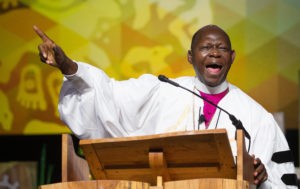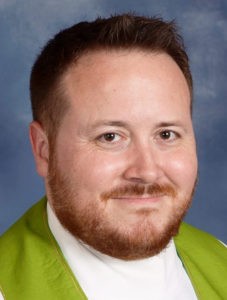When a marriage becomes irretrievably broken, nasty events can transpire in the dissolution. Such has occurred in the past month as The United Methodist Church faces the launch of a breakaway traditionalist denomination expected to draw an uncounted number of disaffected congregations opposed to LGBTQ inclusion.
Since the Global Methodist Church’s transitional leadership council announced a May 1 launch date, several events have occurred that have confused and alarmed rank-and-file United Methodists.
- A district superintendent and his wife were ejected March 8 from a meeting organized by the Florida chapter of the Wesleyan Covenant Association, the founding organization of the Global Methodist Church. Two days later, a UMC clergywoman also was escorted out of a WCA meeting. Both gatherings were held at United Methodist churches, an incursion that some observers hyperbolically likened to Russia invading Ukraine. The WCA Florida president, Jay Therrell, a former United Methodist clergyman, asserted that he was justified in removing those persons, not GMC supporters, because the WCA paid rent to the local churches for meeting space and provided liability insurance, both common practices when churches rent to outside groups.
- The Council of Bishops asked the Judicial Council, the UMC’s “supreme court,” for a declaratory ruling on whether an annual (regional) conference could disaffiliate in the same way local congregations are allowed to do. The annual conference is the “basic unit” of the UMC; hence a conference’s departure significantly depletes the remaining organization in many ways. The request reportedly was spurred by the actions of Bishop Scott Jones of Houston-based Texas Annual Conference, a GMC supporter who has indicated he wants his conference to join the new denomination and has offered his assistance to those writing resolutions to that effect.
- The Council announced March 15 that bishops will follow the dictates of Paragraph 2553 of the Book of Discipline, the collection of UMC laws and policies, in processing local-church withdrawals. Bishop Cynthia Fierro Harvey, president of the Council of Bishops, detailed the procedure in a letter to the Louisiana Annual Conference.
- Wespath Benefits and Investments, the UMC’s clergy pension and health insurance agency, issued a memo March 17 debunking most of the rumors about churches being able to secede from the UMC without paying the money required by Paragraph 2553.
As of March 22, further legal particulars of the UMC’s divorce remain in flux, as they will for years to come while departures proceed. In the meantime, one of the surest ways to understand the break-up is to follow the money, and that requires a review of the past three years.
One of the surest ways to understand the break-up is to follow the money, and that requires a review of the past three years.
In February 2019, the UMC held a special session of its worldwide legislative assembly, General Conference. Several proposals for relieving the 50-year-old battle over LGBTQ acceptance were floated. The most prominent of them, the One Church Plan, offered a kind of “live-and-let-live” arrangement in which the UMC’s official bans on LGBTQ acceptance would be removed from the Book of Discipline and local churches would have the option to determine their own policies. Instead, traditionalists mounted a forceful campaign for their own scheme, which triumphed over the One Church Plan by a mere 58 votes.
The traditionalists’ plan retained the dictum that “homosexuality is incompatible with Christian teaching.” Traditionalists also enacted punitive measures against United Methodist clergy who perform same-sex marriages and reinforced the ban on ordaining LGBTQ persons.
By Summer 2019, 75% of U.S. annual conferences had rebelled against the tightened rules by adopting their own “One Church” resolutions and electing slates of centrist and progressive delegates to the 2020 General Conference, the first opportunity at which the 2019 vote could be overturned.

Bishop John Yambasu gives the sermon during morning worship at the 2016 United Methodist General Conference in Portland, Ore. Photo by Mike DuBose, UMNS
As talk of schism increased, Bishop John Yambasu of Sierra Leone called together representatives of various UMC factions in hopes of keeping the denomination together. When it became apparent that no such unity could be achieved, the unofficial group gained the pro bono services of an internationally respected mediator, Kenneth Feinberg, to work out a plan that became known as a Protocol of Reconciliation and Grace Through Separation. (Sadly, Bishop Yambasu was killed in August 2020 in an automobile crash outside the Sierra Leone capital, Freetown, while on his way to preach at the funeral of a United Methodist pastor).
The Protocol is where money becomes prominent. The unofficial agreement proposes setting aside $25 million over four years for the creation of a “traditionalist” denomination, while allotting only $2 million in seed money for “other” (read “progressive”) expressions of Methodism. The Wesleyan Covenant Association, whose president Keith Boyette was on the Protocol negotiating team, proceeded to assert its claim to the $25 million by starting development of the Global Methodist Church. Despite other flexible unity proposals such as the Christmas Covenant written by United Methodists outside the United States, the Protocol appeared on its way to approval at the 2020 General Conference.
Then the coronavirus pandemic hit. Organizers postponed General Conference three times because of the public health threat. No General Conference, no Protocol vote, and no $25 million for a new denomination.

Keith Boyette
The third postponement, announced March 3 this year, was the final straw for proponents of the Global Methodist Church, aka the Wesleyan Covenant Association, which immediately set May 1 as the GMC’s launch date. The two groups are virtually indistinguishable, given that WCA president Boyette, a retired clergyman and practicing attorney, serves as chair of the GMC’s transitional council.
Now, with WCA informational meetings happening in Florida and elsewhere, the WCA/GMC strategy appears to be undermining Paragraph 2553 to gain as much money as possible for the GMC without having to wait until 2024, when General Conference is scheduled to resume and could take up the Protocol.
This is the proverbial chunk o’ change.
According to Wespath, the current total unfunded pension liability — part of what churches must pay to leave the UMC — stands at $2.2 billion. The companion portion of the payoff, the “fair share” contribution for denomination-wide ministries, varies according to the formula used by each annual conference, but the projected church-wide budget for 2023-2026 is $407.3 million.
Each congregation’s withdrawal payment would be calculated according to its localized share of these two massive amounts, along with whatever local funds the conference would set. These payments are required because the UMC operates with a “trust clause,” meaning the local churches hold their real and personal property “in trust” for the annual conference that provides start-up funding for congregations.
Thus, the annual conference is the key unit deciding these payouts. The two major factions now are contending over conferences the way divorcing spouses fight over who gets custody of the children. So far Northwest Texas Conference is on record by non-binding vote of wanting to join the GMC, while strong sentiment for leaving is being expressed in other conferences including Florida, South Georgia, Texas, and similarly traditionalist regions that once made up the racially segregated Methodist Episcopal Church, South.

Jeremy Smith
According to Jeremy Smith of the Hacking Christianity blog, “It’s a race against time: the UMC hierarchy wants clarity if an annual conference can leave, and the GMC leadership wants a quick decision by an annual conference to leave so it is a done deal for external courts to decide before our internal court would decide on it.”
Smith continues: “Without the Protocol’s $25 million from the denomination as seed money, the GMC would be cash-strapped to pay (a) huge amount, but good for them, they suddenly have an entire annual conference worth of property and assets that is now affiliated with them. They could liquidate any assets an annual conference might have to pay the debt.”
Smith gave the Texas Conference as a case study, estimating its pension liability alone would be around $57 million.
As the elephants of the UMC and the GMC fight over the money, grassroots United Methodists suffer, to paraphrase an African proverb.
An ad hoc group of centrist and progressive delegates issued an open letter to the denomination urging United Methodists to focus on ministry and mission now, without waiting for the 2024 General Conference to decide the denomination’s fate. The letter is intended “to send a clear message that United Methodists of good faith are working toward a vital future for the church,” said an introductory email distributed by Lonnie Chafin, treasurer of the Northern Illinois Annual Conference and a 2020 General Conference lay delegate. “Division cannot be the only response to the challenges of this moment.”
“Division cannot be the only response to the challenges of this moment.”
Eric Swanson, pastor of Grace United Methodist Church in Pekin, Ill., told United Methodist Insight that he views the statement as a key perspective to counter recent “disparaging” messages about the UMC.
“I feel that a lot of the messages we’re hearing have a lot of negativity, and we wanted to speak positively about the future of the church,” he said.
Another unofficial body, United Methodist Association of Retired Clergy and Friends, plans a webinar April 5 titled “To Stay or Not to Stay, That Is the Question Facing United Methodists.” UMARC says the webinar will explore “the choices and consequences of a UMC split.” The panel for the webinar discussion includes three men from the Western Pennsylvania Conference who have published two analyses comparing the GMC’s “Transitional Book of Doctrine and Discipline” with the UMC’s Book of Discipline.
Aside from church politics, emotions around the impending UMC divorce perhaps were best expressed recently by Steve Harper, a retired seminary professor and former traditionalist, who wrote in a blog post:
 I do not say “good-bye” apart from a deep sadness. … I do not say “good-bye” apart from the remembrance that until I was 66 years old (Lent of 2014), I lived and worked in the part of the UMC that is soon to become the GMC. My time included leadership in Good News and the Confessing Movement, as well as teaching/administration at Asbury Theological Seminary — the seminary now most-aligned with the WCA/GMC split. I did all this in the context often described as “welcoming but not affirming” — that is, thinking I was being as relational and charitable with LGBTQ people as the gospel would allow. …
I do not say “good-bye” apart from a deep sadness. … I do not say “good-bye” apart from the remembrance that until I was 66 years old (Lent of 2014), I lived and worked in the part of the UMC that is soon to become the GMC. My time included leadership in Good News and the Confessing Movement, as well as teaching/administration at Asbury Theological Seminary — the seminary now most-aligned with the WCA/GMC split. I did all this in the context often described as “welcoming but not affirming” — that is, thinking I was being as relational and charitable with LGBTQ people as the gospel would allow. …
My parting word to GMC folks is that in beginning a new denomination which continues a non-affirming theology of human sexuality that then prohibits full access by LGBTQ persons to the church’s ministries (ceremonies and callings) you are providing a seedbed where other divisive, regulatory, and exclusionary seeds can grow, as they have done in other split-off denominations. …
My witness to those who will remain in the UMC is this: If you want to be in a denomination where biblical authority, a credible theology of human sexuality, and a commitment to love God with all your heart, soul, mind and strength, and your neighbor as yourself is in full force — you need not leave.”
Cynthia B. Astle is a veteran journalist who has covered the worldwide United Methodist Church at all levels for more than 30 years. She serves as editor of United Methodist Insight, an online journal she founded in 2011.
Related articles:
Now there appear to be three paths for once-united Methodists
Top-down schism plans ignore local United Methodist churches’ new reality
New denomination declares ‘liberation’ from United Methodist Church


